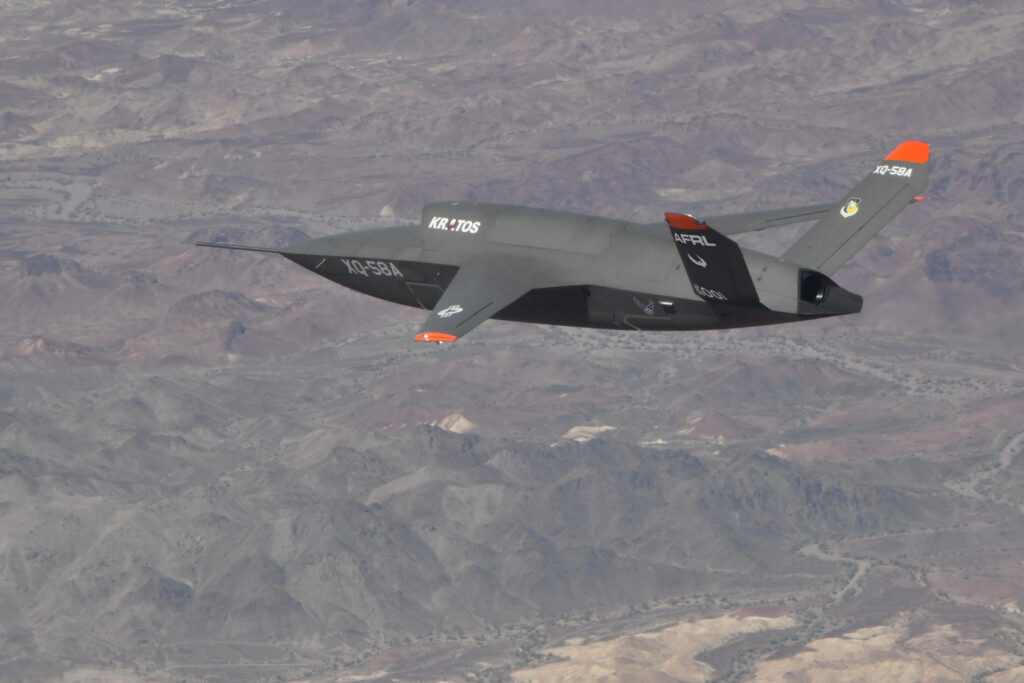
XQ-58A Valkyrie drone built by Kratos
UPDATED To Include Kratos Comments
WASHINGTON: The four winners announced yesterday in the Air Force’s highly-anticipated contest for the Skyborg demonstration program — Boeing, General Atomics, Kratos and Northrop-Grumman — are all big names in autonomous systems. So, perhaps the most surprising thing about yesterday’s announcement is who didn’t win, says Roman Schweizer of Cowen Washington Research Group: “We’re surprised that Lockheed Martin didn’t make the cut.”
Schweizer’s analysis, released today, also noted a item earlier this week in Dealreporter, a market-watch publication, speculating that Lockheed Martin might be interested in acquiring Kratos — a report that caused a subsequent 12.4 percent jump in Kratos stock. “With Lockheed now on the outside looking in,” he wrote, “an acquisition or partnership with Kratos would make sense for more reasons than just Skyborg.”
As Breaking D readers know, Skyborg one of the high-priority “Vanguard” programs initiated by Air Force Research Lab (AFRL), aimed at creating an artificial intelligence (AI) “brain” to pilot low-cost “attritable” drones for a variety of missions. Leidos on May 19 won a $28. million contract to serve as “systems design agent” for the program.
The aspect that has caught the most attention is the concept of Skyborg-driven drones that would provide data (such as telemetry, flight plans and weather) to a manned fighter leading a formation — a job that a wingman’s aircraft normally would do. Indeed, the Air Force’s top priority in its 2021 unfunded priorities list was $25 million to speed up Skyborg prototyping in order to rapidly field a capability to Indo-Pacific Command.
“The aim of the Skyborg Vanguard program is to integrate autonomous attritable unmanned air vehicle (UAV) technology with open missions systems to enable manned-unmanned teaming,” stated a press release from Air Force Life Cycle Management Center. AFLCMC is managing the four indefinite-delivery/indefinite-quantity (ID/IQ) contracts, with a combined ceiling of $400 million, in a partnership with AFRL.
“Because autonomous systems can support missions that are too strenuous or dangerous for manned crews, Skyborg can increase capability significantly and be a force multiplier for the Air Force,” said Brig. Gen. Dale White, AFLCMC’s program executive officer for Fighters and Advanced Aircraft, in the release.
“Autonomy technologies in Skyborg’s portfolio will range from simple play-book algorithms to advanced team decision making and will include on-ramp opportunities for artificial intelligence (AI) technologies,” added Brig. Gen. Heather Pringle, the new AFRL commander. “This effort will provide a foundational Government reference architecture for a family of layered, autonomous, and open-architecture UAS.”
No funds under the ID/IQ contracts have yet been released, nor has AFRL stated a date for a down-select. Given that the concept is for a family of vehicles, it raises the possibility that there could be more than one provider chosen in the end, however. (DoD’s contract announcement says only that demonstrations are expected to be completed by July 2026.)
Up to now, Kratos’s XQ-58A Valkyrie is the only drone body that has carried the Skyborg package. It successfully completed the fourth of five planned tests for AFRL’s Low Cost Attritable Strike Demonstrator (LCASD) program on Jan. 23.
UPDATE BEGINS. The Skyborg program — under which firms can offer a variety of platforms for production under the ID/IQ contract vehicle — is separate from the LCASD program testing Valkyrie, a Kratos official told Breaking D.
Kratos also still intends to participate in the upcoming Advanced Battle Management System (ABMS) “OnRamp” exercise — originally planned for April, but delayed by COVID now set for Aug. 31-Sept. 4. UPDATE ENDS.
Air Force acquisition chief Will Roper told reporters at the time that he expected the Valkyrie equipped with Skyborg to fly during the second OnRamp exercise, which are testing out technologies for potential inclusion in the ABMS program. As Breaking D readers know, ABMS is building up a portfolio of hardware and software to underpin DoD’s high-priority Joint All Domain Command and Control (JADC2) network for running future all-domain warfare.
The idea, Roper explained, is that Skyborg/Valkyrie would carry the ABMS gatewayONE, a radio and antenna set — built by Lockheed Martin, Northrop Grumman and Honeywell — which translates the separate machine languages of the F-35 and F-22 fighters to allow them to communicate with a low probability of detection. GatewayONE was successfully tested on the ground during the first multi-service ABMS exercise held Dec. 16-18, using both Navy and Air Force F-35s along with F-22s.
Australia tops up Ukraine military aid with $100M
Australia has already supplied Ukraine with 120 Bushmaster vehicles, six 155mm howitzers, 56 M113 armored vehicles, 14 special operations vehicles and its signature cardboard drones.



























